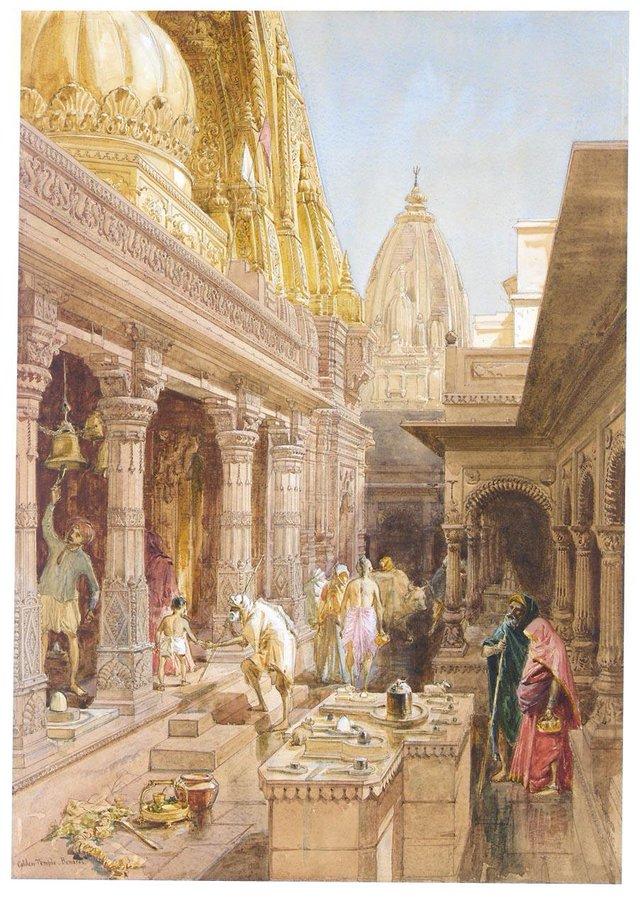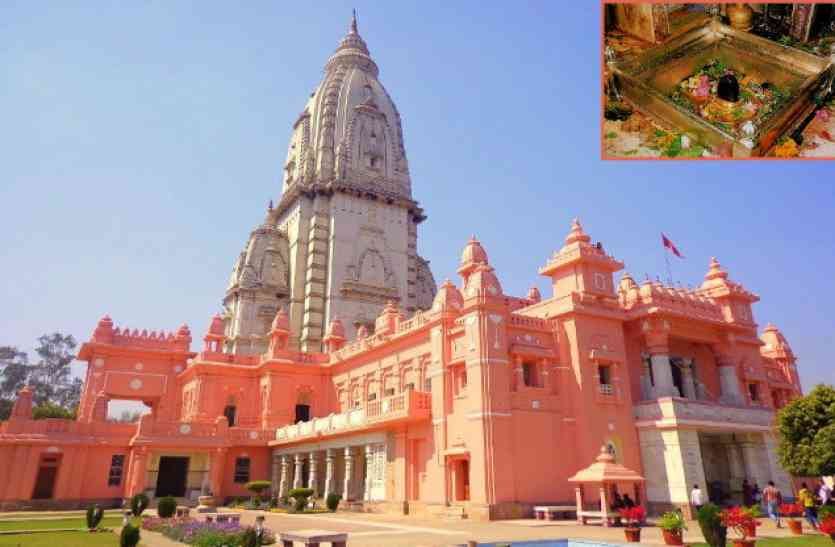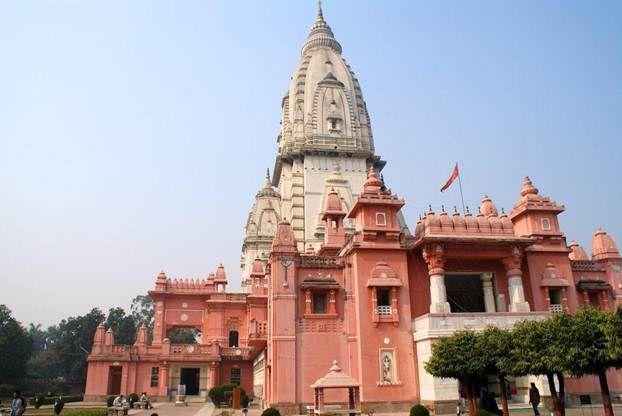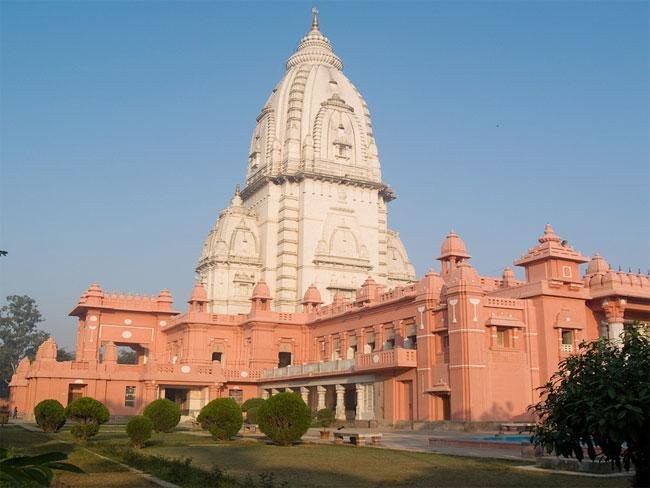Contents
Kashi Vishwanath Temple, Varanasi, Uttar Pradesh
Kashi Vishvanath Temple is one of the most famous Hindu temples dedicated to Lord Shiva. It is located in Varanasi, Uttar Pradesh, India. The temple stands on the western bank of the holy river Ganga, and is one of the twelve Jyotirlingas, the holiest of Shiva temples. The main deity is known by the name Vishvanatha or Vishveshvara meaning Ruler of The Universe. Varanasi city is also called Kashi, and hence the temple is popularly called Kashi Vishvanath Temple. Its name originally was Visvheshvara (broken down Vishwa: Universe, Ish: Lord; Vara: Excellent) or Lord of the Universe.
The temple has been referred to in Hindu scriptures for a very long time as a central part of worship in Shaiva philosophy. It has been destroyed and re-constructed a number of times in history. The last structure was demolished by Aurangzeb, the sixth Mughal emperor who constructed the Gyanvapi Mosque on its site. The current structure was built on an adjacent site by the Maratha ruler, Ahilya Bai Holkar of Indore in 1780.
Since 1983, the temple has been managed by the government of Uttar Pradesh. During the religious occasion of Shivratri, Kashi Naresh (King of Kashi) is the chief officiating priest.
Architecture
The temple complex consists of a series of smaller shrines, located in a small lane called the Vishwanatha Galli, near the river. The linga of the main deity at the shrine is 60 cm tall and 90 cm in circumference housed in a silver altar.The main temple is quadrangle and is surrounded by shrines of other gods. There are small temples for Kaalbhairav, Dhandapani, Avimukteshwara, Vishnu, Vinayaka, Sanishwara, Virupaksha and Virupaksh Gauri in the complex. There is a small well in the temple called the Jnana Vapi also spelled as Gyaan vapi (the wisdom well). The Jnana Vapi well sites to the north of the main temple and it is believed that the Jyotirlinga was hidden in the well to protect it at the time of the invasion. It is said that the main priest of the temple jumped in the well with the Shiv Ling in order to protect the Jyotirlinga from invaders.
According to the structure of the temple, there is a Sabha Griha or Congregation Hall leading to the inner Garbha Griha or Sanctum Sanctorum. The venerable Jyotirlinga is a dark brown coloured stone that is enshrined in the Sanctum, placed on a silver platform. The structure of the Mandir is composed of three parts. The first comprises a spire on the Mandir of Lord Vishwanath or Mahadeva. The second is a gold dome and the third is the gold spire atop Lord Vishwanath carrying a flag and a trident.
The Kashi Vishwanath temple receives around 3,000 visitors every day. On certain occasions, the numbers reach 1,000,000 and more. Noteworthy about the temple is the 15.5-metre high gold spire and gold dome. There are three domes each made up of pure gold.
Legend / Local stories

The temple has been mentioned in the Puranas including the Kashi Khanda (section) of Skanda Purana. The original Vishwanath temple was destroyed by the army of Qutb-ud-din Aibak in 1194 CE when he defeated the Raja of Kannauj as a commander of Mohammad Ghori. The temple was rebuilt by a Gujarati merchant during the reign of Delhi’s Sultan Iltutmish (1211-1266 CE). It was demolished again during the rule of either Hussain Shah Sharqi (1447-1458) or Sikandar Lodhi (1489-1517). Raja Man Singh built the temple during Mughal emperor Akbar’s rule, but orthodox Hindus boycotted it as he had let the Mughals marry within his family. Raja Todar Mal further re-built the temple with Akbar’s funding at its original site in 1585.
In 1669 CE, Emperor Aurangzeb destroyed the temple and built the Gyanvapi Mosque in its place. The remains of the erstwhile temple can be seen in the foundation, the columns and at the rear part of the mosque.
In 1742, the Maratha ruler Malhar Rao Holkar made a plan to demolish the mosque and reconstruct Vishweshwar temple at the site. However, his plan did not materialize, partially because of intervention by the Nawabs of Lucknow, who controlled the territory. Around 1750, the Maharaja of Jaipur commissioned a survey of the land around the site, with the objective of purchasing land to rebuild the Kashi Vishwanath temple.[7]:85 However, his plan to rebuild the temple did not materialize either. In 1780, Malhar Rao’s daughter-in-law Ahilyabai Holkar constructed the present temple adjacent to the mosque. In 1828, Baiza Bai, widow of the Maratha ruler Daulat Rao Scindhia of Gwalior State, built a low-roofed colonnade with over 40 pillars in the Gyan Vapi precinct.[8] During 1833-1840 CE, the boundary of Gyanvapi Well, the ghats and other nearby temples were constructed.A 7-feet high stone statue of Nandi bull, gifted by the Raja of Nepallies to the east of the colonnade. Many noble families from various ancestral kingdoms of Indian subcontinent and their prior establishments make generous contributions for the operations of the temple. In 1841, the Bhosales of Nagpur donated silver to the temple. In 1835, Maharaja Ranjit Singh donated 1 tonne of gold for plating the temple’s dome.
The temple was managed by a hereditary group of pandas or mahants. After the death of Mahant Devi Dutt, a dispute arose among his successors. In 1900, his brother-in-law Pandit Visheshwar Dayal Tewari filed a lawsuit, which resulted in him being declared the head priest.
Photo Gallery


![kashi-vishwanath-temple[1] (1), Kashi Vishwanath Temple, Varanasi, Uttar Pradesh](https://www.bharattemples.com/wp-content/uploads/bt/2018/12/kashi-vishwanath-temple1-1-1.jpg)

How to Reach:
Contact Details
Official Address
